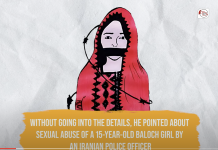All the education institutes in Balochistan have been shut off until further notice; all the shopping malls, restaurants, public transport, and crowded places have been ordered to close for the next three weeks. Public gatherings having more than ten people are officially illegal for the time being.
All these measures might sound pro-active but this is not the case. These are responses were shown in the aftermath of the Coronavirus outbreak.
At the end of January, The virus had already found new lands outside China. Iran reported her first Corona virus-related case on 19th February and after a month 20,610 people have been affected and 1,556 people have lost their life. Balochistan, sharing a border of 954 Km with Iran, was under the radar and radical measures were needed to stop the virus enter its border.
On 24 February, the Iran-Balochistan border was closed and entry points in 5 districts were also shut-down. But on 28 February, Entry points which are being called the ‘flood-gates of the virus’ by some politicians, were opened again. 6000 people crossed the border including pilgrims and other people.
Although, the establishment of quarantine centers is the Federal government’s responsibility but the provincial government decides to show their ability (naïvetés) and treated the influx of people as they were not virus affected but earth-quake affected.
The provincial government built a tent-city in the border town of Taftaan, which turned out to be incubation centers for the virus growth instead of quarantine centers to smother the growth of the virus. This has brought shame for the provincial government nationally and internationally.
Why incubation center? Almost a thousand pilgrims were sent to Sindh province and 165 have been tested positive out of 537 totals tests carried out. Pilgrims who reached other parts of the country too have a big ratio of being affectees as 519 cases have been confirmed in Pakistan. Shockingly, Balochistan has 105 cases.
Balochistan has a low population and 105 cases mean every one person among a million is already affected and this virus has the potential to grow exponentially. The figures only relate to cases tested and analyzed, and therefore doesn’t reflect the exact number of people infected. What next?
The crisis has hit the region, but disaster can still be avoided if radical measures are taken quickly. A complete lockdown has shown good results across the world but only when adequate arrangements have made to facilitate the people staying at homes.
Hospitals must be equipped on war-footing bases, quarantine centers (not tent-cities) must be established in every district and all necessary products from masks to hand sanitizers must be made available in every city to avoid the disaster.





























